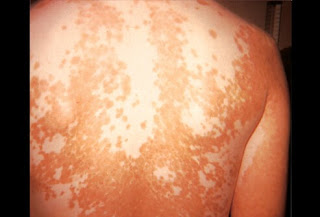Vitiligo is one of the most common autoimmune skin diseases and is caused by a lack of melanin, the pigment that gives skin its colour: the body’s immune system attacks the pigment cells, mistaking them for foreign invaders. This causes painless white patches on exposed areas such as the face and fingers, although they can also appear on the wrists, around the eyes, groin, armpits and inside the mouth.
Stressful activities like childbirth, hormonal changes or skin injury may trigger it, it could also be genetic, it affects all skin types, but not visible on fair skin. There are two types of vitiligo-generalised symmetrical type: it affects both sides of the body symmetrically and segmental vitiligo which affects only one area of the body and is less likely to progress- it is more responsive to treatment because a smaller area is affected.
Presently, there is no cure for vitiligo, but some treatments can reverse pigment loss if used early. These include topical steroids-to calm inflammation, and vitamin D cream, thought to have a protective effect on melanocytes, the cells that produce pigment in skin. Other options include pimecrolimus and tacrolimus, creams that are usually used for eczema, which can repigment the skin, protecting the skin from the sun is also important, as the white areas have no pigment to protect them from ultraviolet light. The use of narrow ultraviolet B light phototherapy can be useful with protopic cream, an immunosuppressant treatment that turns off the autoimmune reaction.
The ultraviolet light stimulates the melanocytes in a similar way, melanocytes proliferate when exposed to sunlight, to darken and protect the skin against sun damage. Another option is PUVA psoralen ultraviolet A light treatment, where the patient is given a drug to make them more sensitive to light, they are then exposed to UV light twice weekly for up to two years.
For pigment transplant, researchers prepared the skin by using either a laser or a tool to injure the vitiligo patch, making it ready for the transplanted cells, the method is suitable for patients that have vitiligo that affects only a small area and has been stable for at least six months. 1-2cm square of skin from the thigh is removed taking just a thin, superficial layer, and put this into a chemical solution. This separates the pigment cells from fibrous tissue. Harvesting the cells from the chemical solution with a syringe and apply it to the area of skin affected by vitiligo, followed by Excimer laser treatments to correct the disease.
haleplushearty.blogspot.com


